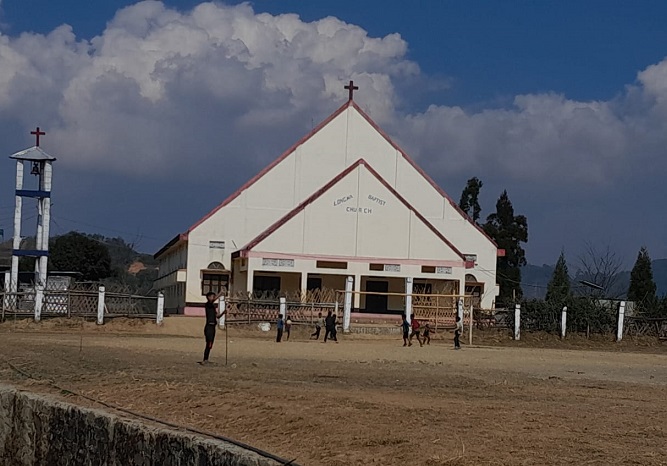Nirendra Dev / From Longwa (Indo-Myanmar border in Nagaland)
Fifty year old ‘Aang’, local Konyak Naga king, Tonyei Phawang gives a pensive look. Standing at the gate of his house; he says– “My right hand is in Myanmar and left in India. Now the government of India decision to put on border fencing will divide my house”.

He is not in isolation. Scores of others including women and youth share his pessimism.
However, despite some angry outbursts, the native tribes would not like to be seen as creating hurdles in India’s effort to secure its border.
The central government has announced a plan to “seal” its open border with Myanmar amid news of refugees from the troubled neighbour entering its northeast region – especially states such as Mizoram and Manipur.
The decision will impact the social and family lives of indigenous tribes such as Nagas and Mizos who share ethnic affinity and kinship ties that cut across political borders.
Nagaland shares 215 Km border with Myanmar where while military junta is in power. But various ethnic groups are putting on strong resistance and even taking military control of some pockets in Myanmar.
According to announcement made by union Home Minister Amit Shah, the central government will establish a fence along India’s 1624 km that runs through Manipur, Mizoram, Nagaland and Arunachal Pradesh.
The plan “to fence the India-Myanmar border” and “reconsider the Free Movement Regime (FMR)” was made public by Shah on Jan. 20 in Guwahati. Shah is well known as a close confidante of Prime Minister Narendra Modi.

While chief ministers of two provinces Nagaland- Neiphiu Rio and Mizoram – Laldudoma are opposing fencing, two BJP chief Ministers N Biren Singh of Manipur and Pema Khandu of Arunachal Pradesh are keenly supporting the fencing. In fact, the Manipur Chief Minister is said to have proposed the move for fencing which the union government in Delhi readily agreed.
Around 6,000 refugees from Myanmar have taken shelter in Manipur state, authorities confirmed in December 2023.
At the height of the ethnic violence in Manipur last year, Shah had blamed the influx of Kukis from Myanmar. This was creating “insecurity among the Meiteis,” the home minister told parliament on Aug. 9, 2023.
New Delhi is perhaps concerned that the problem might just grow bigger.
The Nagas have been demanding a “Greater Nagalim,” a homeland for Naga people spread across contiguous Naga areas, both in India and Myanmar.
Similarly, a demand for “Greater Mizo land” was raised by Mizo leaders in the 1980s. Nagaland Chief Minister Neiphiu Rio has opposed fencing saying, “We have to work out a formula on how to solve the issue of the public and also to prevent infiltration”.
He also visited Longwa in remote Mon district on Feb 10. At a public function, he however said, there have been movements of armed militant cadres and rebels in India sneak out across porous border and take shelter in ‘safe havens’ in Myanmar.
Quoting management guru Shiv Khera, he also said, “Freedom is not free…you are free only within the rules”. Many Naga inhabitants say even their Agricultural land is in Myanmar area where they go during farming. “All these issues ought to be discussed and understood well,” says village head of Longwa, Wangnei Konyak.
Mizoram Chief Minister Pu Laldumoma, a Christian Mizo native tribal, has also raised a bannerof revolt but goes on to say that he is helpless before the mighty central government.
“If the central government headed by PM Narendra Modi goes ahead with its plan to fence the India-Myanmar border and scrap the Free Movement Regime (FMR); we have no authority and we cannot stop it,” he said.
International issues and border management fall under the responsibilities of the federal government in India.
Mizoram’s Champhai district adjoining Myanmar witnessed the most with about 2,500 intruders from Haimual and Khawmawi in the Chin region taking place in February 2022.
Altogether, more than 31,000 people from Myanmar, mostly from the Chin state, have taken refuge in Mizoram following the military coup in the neighbouring country in February 2021.
Considering their demographic spread in the region, both Naga and Mizo communities may have a valid point in wanting to live in a common administrative area. But this is easier said than done considering the geo-political and security situations.
Meanwhile, many people in Myanmar are considering leaving the country, fleeing to border areas controlled by ethnic minorities or are also considering joining rebel groups. The reason being the junta’s newly activated conscription law that makes military service mandatory for two years for men aged 18-35 and women aged 18-27.
On Wednesday (Feb 14), the junta said that it would draft 60,000 young men and women for military service under the conscription law. The call-ups would begin after the Thingyan New Year celebration in April.
The activation of the law has caused fear, defiance and anxiety among young people and their families.
On February 6, India’s ministry of external affairs (MEA) issued an advisory for Indian nationals to not travel to western Myanmar’s Rakhine State.
Those based there have been urged to leave immediately.
Security forces deployed in border areas of Nagaland and Mizoram, however, say once a policy decision is taken by the Government of India, the orders will be implemented strictly.
They also say besides bringing down infiltration, there will be a significant scale down in smuggling of drugs and even China made goods. The reports of smuggling of arms from across the border and “easy movement” by militants will also be checked, they say.
